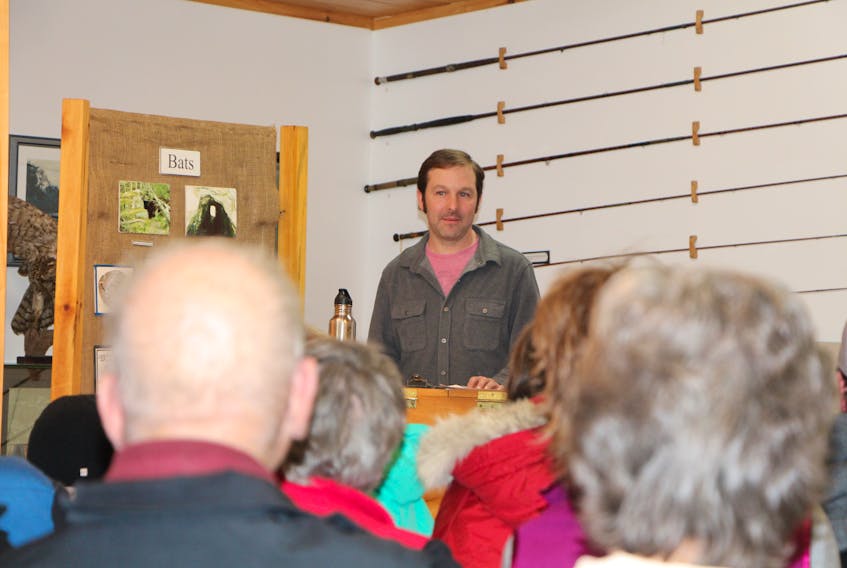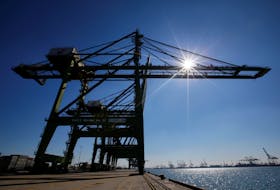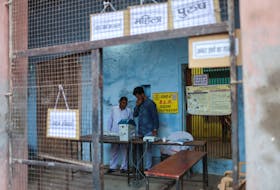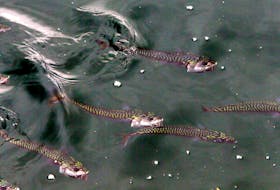When asked if they want to see another mine in the Municipality of the District of St. Mary’s, the members and supporters of the St. Mary’s River Association (SMRA) have one thing to say; nope.
That response also serves as the acronym for the name of a movement that has arisen to renounce the idea of a new gold mine in the area: No Open Pit Excavation (NOPE).
NOPE is a response to a proposed mine at Cochrane Hill – one that will be the largest in the reason, if work is allowed to commence on the project.
Scott Beaver, president of the St. Mary’s River Association, hosted a talk on the dangers of plans by Atlantic Gold to construct the largest gold mine in St. Mary’s.
“Investments that span decades shouldn’t be risked for a company wanting profit,” Beaver said. “It doesn’t make sense to let a large, intrusive risky industry into the area … for short-term gain. We have too much to lose as a community.”
Among the dangers Beaver and the SMRA see is the enormous water requirements – 500,000 cubic meters for the startup and 50,000 liters a day – an amount that could have a tremendously dangerous effect on the local water tables it is drawn from in the region (the St. Mary’s River and Archibald Lake), and the wildlife that inhabit them.
The mine would have a 600-acre footprint, with a 70-acre open pit, a 260-acre tailings pond, leading to tree loss, which would leave the area open to habitat loss for wildlife, water loss and accumulation of silt and other pollutants. Also affected would be air quality and quality of life from the noise, dust and dirt from blasting released into the air on a regular basis. Heavy metals, Beaver noted, would be released into the air, as well.
Beaver said acid mine drainage would pollute waterways and impact the quality of drinking water. This would lead to a decline in local wildlife, both commercial and recreational fishing, and tourism in the area.
Beaver noted that this would be dangerous to four species in particular; Atlantic Salmon, wood turtles, snapping turtles and brook floater fresh water mussels.
Of specific concern to Beaver and the SMRA was the potential for problems with the tailings ponds the mine would need, if it were to go into operation.
“Tailings ponds are a worldwide major environmental issue. They have to be isolated from the environment. When they’re done with it, it all stays there,” Beaver said, noting that tailings could contaminate local water, leaching into the tributaries and streams of the St. Mary’s River.
Beaver noted that a breach of a tailings pond from an extreme weather event could be disastrous, referencing the damage wrought in the Mount Polley mine disaster in B.C., when the Mount Polley copper and gold mine’s tailings pond was breached during a flood, releasing tremendous amounts of mining waste into the Polley Lake and, eventually, the rivers of the Cariboo Valley.
Beaver said the mine would undo years of work the SMRA has done to preserve the environment and species in the St. Mary’s watershed, such as the salmon recovery strategy implemented in 2010.
He noted that Atlantic Gold “could be long gone or bankrupt before any problems become evident,” noting that the bond they are required to put in place for the Cochrane Hill mine would likely be inadequate to cover the potential for damage.
“It would be only six years of production,” Beaver said. “The pro is that a few jobs would come to the region, providing about six to 10 years of work. Local businesses would see an increase in activity, and some organizations would receive funding for their programs.”
The crowd of guests that filled the St. Mary’s River Association Interpretive Centre were not convinced by any of the potential benefits Atlantic Gold touted.
“This province was built on industrial ingenuity, but Cochrane Hill would be nothing but industrial insanity,” said one guest, summing up what the majority of those attending the meeting were thinking. Most of the guests were overwhelmingly against the idea of a new gold mine in the region, and the consequences it would entail for the environment.
The consensus of those at the meeting was that a federal level assessment was needed, as well as objective oversight, to ensure that any effect the mine would have, was accounted for.
A common refrain from guests who attended the meeting was that there needed to be more certainty as to whose side council was on. No members of council attended the meeting on the evening of Dec. 5 – something guests took notice of.
“We have to find out where council is at. Are they for or against it?” one guest said. “You, as a community have to ask hard questions to council. If they’re not on this one, who do we have working for us?”
Beaver stressed the importance of talking to councilors, as well as Central Nova MP Sean Fraser. He also suggested putting pressure on the government to demand that Atlantic Gold provide a larger bond to account for potential environmental damage, if they want to mine in the area.
Guests also expressed doubt that the new mine would bring as many employment opportunities to St. Mary’s as Atlantic Gold claimed.
“Atlantic Gold is always saying they will create 200 or 300 jobs. I doubt that,” another guest said.
“In the project description, they said 190 jobs,” Beaver said. “But when you ask directly, they will not give you an answer.”
Another guest replied, “Sometimes that number is for people who will come here for a year with no intention of staying afterwards when the mine shuts down.”
The SMRA is working to amass support for its efforts to shut down the Cochrane Hill mine project. Beaver asked guests to sign a petition and get in touch with elected officials, to make their message of opposition loud and clear.
Municipal position
Marvin MacDonald, CAO of the Municipality District of St. Mary’s, said the district fully recognizes the SMRA’s position on the Cochrane Hill mine. He noted neither he nor Warden Michael Mosher were able to attend, due to another function they were required to attend that night.
“The river has been a very important part of the community here for a long time,” MacDonald said. “We take no exception to their statement of position that they are opposed to the gold mine”
MacDonald noted Atlantic Gold has engaged in a reasonable amount of consultation, speaking to council a few times to talk about their proposed mine.
“They’ve certainly been open to answer questions from the municipality and councillors. They’ve formed a liaison committee, which has a number of representatives present on the committee.”
MacDonald added he understands the position of the SMRA, noting “I understand they would prefer not to have any activity within the watershed of the river, whatsoever.”
“The understanding around the council table is that we respect that position, and the fact that their sole mandate is the St. Mary’s River,” he added.
Macdonald said Atlantic Gold is still in an early stage of the process. They submitted their project description to the Canadian Environmental Assessment Agency.
“I understand that takes the better part of the year to work its way through,” MacDonald added.
MacDonald said the company is seeking feedback from the community, and plans to set up a location where residents can go in and ask questions, and get an overview of the plans for the Cochrane Hill mine site.
“They want to set up a storefront for a couple days a week, and are looking to do that as soon as possible,” MacDonald said.
The Cochrane Hill area is not an unfamiliar territory for mining. It, along with nearby Goldenville, is a place where plenty of mining and exploratory work have gone on in the past.
“Historically, the number one location of mining in the district is the Cochrane Hill site. We have a history of gold mining in the region,” MacDonald said. “









